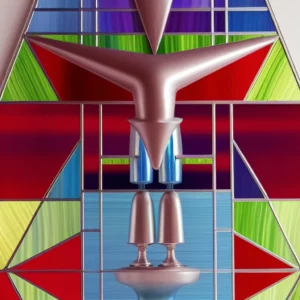Decluttering Tips
I’ve been decluttering my garage for the past few weeks, so here are some decluttering tips I’ve figured out for processing, purging, and organizing, especially if you have a lot of old tech clutter to deal with.
Approach Decluttering with Patience
Just chip away at the project one item at a time, not worrying about how long it will take. It’s wise to approach such a project with great patience, allowing it to take as long as it wants to take without feeling any need to rush.
I put this project off for years because I could never squeeze it into any kind of schedule. I only made significant progress when I gave this project a totally open-ended schedule with no deadline, opting to do it right instead of trying to rush through it. Surrendering to the unpredictable duration of the project helped tremendously.
Switch Fully into Personal Mode
I could never make headway with this project when I was in work mode by default. I could only get it done by making it a priority, which meant that I also had to take a slice out of my year to prioritize my personal life above my business goals. That’s a hard thing for me to do, but I viewed and approached it as a personal growth exploration to see what it would be like to put my work life on the back burner and to elevate my personal goals for a while.
While working on this project, I haven’t written any articles, for instance. My last blog post was written 47 days ago, so that’s almost 7 weeks off from writing.
And actually it’s been wonderful. I feel like I should take a significant slice out of every year and do this sort of thing. I’ve been able to slide into non-work mode while traveling, but since I work from home, I found it hard to fully shift into personal mode while at home. Consequently, a lot of home-related and personal projects lingered near the bottom of my to-do list, starved for attention.
Mentally I could always say that I should be able to chip away at these projects on weekends and evenings, but that approach never got the job done. It’s been so much more effective to fully load in the context of doing such a personal project by treating it as my #1 priority for weeks on end. This really is a whole brain task, and by giving it my full attention, not merely my after-work attention, I’m finally getting it done in a way that feels good to me.
Focus on Relationships with Items
For each item, ask questions like these:
- What do I want my relationship with this item to be?
- Is it still meaningful to keep it?
- How would I feel if I let this item go?
- If I want to let it go, what’s an intelligent and regret-free way to process and release it?
I find the regret-free standard especially helpful.
Question Every Item
Invite each item to justify its worth and value to you. Don’t assume that you “should” keep anything just because you’ve held onto it for so long.
I finally let go of some items I’ve had since the 80s or 90s, such as an old tennis racket from high school. It felt good to finally release them, even though I’d previously assumed that I should always keep them.
Challenge some old rules about what you think you must keep. See if those rules still seem valid to you today. Don’t let old rules slide into your default thinking; reassess them anew.
I find it helpful to ask: What rule says I should keep this item?
I had a rule that said I should always keep old trophies and awards. But is that a necessity? No, it’s just a rule I inherited when I was in school. This time I finally purged some awards (like plaques) that weren’t particularly meaningful for me anymore, like from Toastmasters’ speech contests more than 15 years ago.
Process and Recycle Old Electronics
Do the proper research to figure out your best strategy for recycling old electronics. Once you have a process for handling these items, it’s much easier to face electronics clutter.
I learned that Best Buy stores are great for recycling old electronics since they’ve made a commitment to do a lot of tech recycling. They will accept a wide variety of items including old desktops, laptops, cables, mice, keyboards, hard drives, routers, printers, speakers, cameras, VCRs, video game systems, and more – and they’ll take almost everything for free. For details see: bestbuy.com/recycling
Amazon and Best Buy will both give you store credit for certain kinds of tech trade-ins. I traded in a 9-year old iPad (so old that it was limited to iOS 9 – we’re at iOS 14.7 today) and two old Apple TV boxes for some store credit at Best Buy. I traded in an old Sonos speaker and some wireless networking hardware for Amazon credit. Amazon will even pay for the shipping. You may get more money from using eBay, but this is super convenient if you just want to move some items out.
Amazon is a great place to find convenient interfaces for old tech if you want to transfer old data to new devices. For $15-25 you can get a USB interface adapter that can connect directly to 2.5″ and 3.5″ IDE and SATA drives, CD/DVD drives, and floppy disk drives. I had 6 old hard drives from PCs and laptops that I used from 2002 to 2007, and surprisingly all 6 drives still worked, even though most of the computers that housed them had long since died. It’s a simple matter to remove an old drive and connect it to a modern computer, normally requiring only a screwdriver.
Wipe Your Data
I read an article sharing that most people who resell old smart speakers (like Amazon Echo devices) don’t even factory reset their devices. At least do a factory reset before passing on a device, which is relatively easy to do. You can easily look up how to do that for any device with a simple online search.
Mac OS makes it really easy to wipe old hard drives securely by overwriting old data with 3 or even 7 passes to render the drive’s data irrecoverable. Just connect your drive, run “Disk Utility”, select the drive you want to erase, click “Erase”, select the desired security option, and go from there. The old drives I erased ranged from 20GB to 160GB, and it typically took a few hours to throughly erase each one.
Best Buy and other tech recycling places also have arrangements with companies that will destroy the drives for you. This is free at Best Buy while other places may charge a nominal amount. But it’s still a good idea to erase the drives before handing them in.
Alternatively, you can physically destroy an old drive yourself. There are instructions on how to do that in various ways, such as by hammering nails through the platters of old hard drives. Just be sure to wear good eye protection. Personally I think it’s better to let a tech recycling place handle this more professionally with the proper equipment.
Donate to Charity
If there’s a drop-off location near you for charitable donations, that can be a nice way to let go of items. There’s one just a few minutes from me, so I’ve dropped off a lot of items there.
Some charities will also come to your house and pick up items for free. In the past I’ve even donated two old cars this way. The cars wouldn’t even start, but an animal rights charity came by to tow each one away. The charity can still resell the car for some value, and they saved me the trouble of having to deal with it, so that’s a nice win-win.
I don’t like using eBay, so I didn’t use it for any part of this project, but that’s always an option if you like using the service.
Replace Items with Photos
If you want the memory of an item but would prefer to eliminate the clutter, take a photo of it (or several photos) before you let it go. See if it feels good enough to just keep the photo and release the physical item.
I’ve release a number of mildly sentimental items when I realized that a photo would be good enough to retain the memory.
Create the Emotional Vision for the Space
Framing a project as just decluttering can make it seem boring or tedious, so consider more appealing or inspiring frames. A good framing that helped me move my garage project forward was to think about transforming the space into a place in my home that I felt good about – a storage area that’s neat, clean, and nicely organized and that makes me feel relaxed and soothed when I’m there.
Another frame that works very well for me in general is to treat any project as some kind of upgrade. I’m very good at completing projects that I frame this way. So I’m not decluttering the garage; I’m upgrading it from a cluttered space to a well-organized part of my home. The entire project can also be framed as a series of small upgrades. I just find projects more motivating when I frame them as upgrades.
Thinking about how I wanted to emotionally feel inside the space was really helpful, and I think it led to better decisions regarding how to organize it. I could assess how I was doing by how I felt, and I kept taking small steps to align the space with better feelings.
As you make progress, keep asking questions like:
- What part of this space still creates tension for me?
- What part of this space evokes positive feelings in me?
Such questions can be very helpful for deciding which parts to process and upgrade next.
We actually spend a lot of time working on reframes in Conscious Growth Club each year because this is such a powerful and effective method for getting stuck energy moving again. A lot of people think they need to push themselves more to get certain projects done, but that isn’t necessary if you reframe your projects to better align with your natural motivation patterns.
Choose Storage Options That Feel Good to You
My garage didn’t have good storage for the items I wanted to store there, such as camping gear and workshop supplies. Consequently, many items were just lying on the floor of the garage when I began. Partway through the project, I browsed for storage options that would fit my needs and evoke the emotional response I was looking for.
I learned that Costco is a great place to find flexible storage solutions at reasonable prices. I got two sets of these metal shelves for $90 each in the local Costco store on sale. I like that they’re on wheels, which enabled me to commit to using them to organize some items (like camping gear) before I fully decided where I wanted the shelves to end up.
I found it especially helpful to set up these shelves earlier in the project than I initially expected because it allowed me to fully transform one portion of the garage into a nicely organized space. Even though other parts of the garage were still cluttered, upgrading one corner of it to be just how I wanted helped me really lock onto the vibe for how I wanted the whole space to feel. It was very encouraging to have part of the space feel like it was already done, even though other areas still had a ways to go.
Clean It
Cleaning and decluttering go hand-in-hand. Cleaning a space gives it a whole different feeling, like you’ve raised the standard for how that space is to be treated.
I’ve been giving the garage a thorough cleaning as I’ve been going along, including vacuuming up lots of dust and clearing out cobwebs, dead bugs, and leaves. It’s not pristine – it’s a garage after all – but the cleanliness upgrade definitely improves how I feel about the space.
Never Say “Should”
Keep asking:
- What kind of relationship do I ultimately want to have with this space?
- What next action would improve that relationship?
These questions can help you figure out what to do next. Never ask: What should I do next? There are no shoulds… just invitations and possibilities.
Embrace the Mental and Emotional Journey
Processing old possessions isn’t just a physical experience. It can be very mental and emotional. So many items can bring up memories and past associations.
I recommend letting yourself dwell in those thoughts and feelings, giving ample time to process them. You may think that this will slow you down, but it can have a very positive transformational effect as well.
I often felt like I was reconnecting with and reintegrating my past selves through this process. Somehow I feel more internally integrated as a result… and more grateful for the many experiences I’ve had. Processing old physical items helped me process old memories and some stuck energy, which gave me increased feelings of inner peace.
I hope these tips help someone who’s facing a similar decluttering (or upgrading) project.
This project has been going very well by the way. I’d say that I’m 80-90% done now. The garage has a whole different vibe – way better than when I first began. It’s been a surprisingly rewarding project, and it feels so good to reclaim that space for a better purpose than a graveyard of old stuff. Every time I donated or recycled something, I felt a sense of relief and a fresh vibe of possibility, like I’d freed up some energy that had been stuck for years.
Subjectively speaking, I also like to frame the purging of old items as releasing energy back to the Simulator, so that energy can be repurposed to simulate something more interesting. Why require the Simulator to waste cycles rendering old patterns that are no longer needed?




